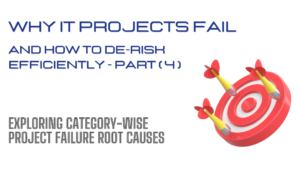The Christmas miracle: A Data disaster averted
A case study in Agile Project Management, and the importance of Preventive measures.
The Christmas Miracle: A Data Disaster Averted
Introduction:
In the realm of IT Project Management, unexpected challenges can arise at the most inconvenient times.
It was a New Year’s Eve we wouldn’t ever forget. Instead of celebrating, our team was huddled around laptops, battling a crisis that threatened to delay the launch of a critical healthcare portal. The experience was a stark reminder of the challenges inherent in Agile development, but it also revealed the incredible resilience of our team, the importance of clear communication, and the power of a shared commitment to delivering for our clients.
Project Overview: Transforming Member engagement in Healthcare
The project aimed to revolutionize the way our client interacted with its members by developing a comprehensive and secure member portal. At the time, our client lacked a solution to provide members with convenient access to their health information, self-service options, and digital communication channels with healthcare providers. The answer to the problem in hand was to develop a member portal solution for our client.
The member portal was envisioned as a central hub for member engagement, offering features like:
● Preventative care reminders: Prompts for checkups, screenings, and physician appointments, encouraging proactive health management.
● Premium payment reminders: Timely reminders to avoid lapses in coverage.
● Health advice from professionals: A platform for members to seek guidance and support from healthcare professionals.
This comprehensive member portal promised to be a game-changer for the client, not only enhancing member satisfaction but also potentially reducing administrative costs and improving healthcare outcomes through increased member engagement. However, the path to achieving this vision was not without its hurdles.
With a tight deadline and a complex set of requirements, the project team faced the daunting task of balancing agility with the structured approach of a waterfall model. The integration with a third-party hosted application added another layer of complexity, introducing potential points of failure that would soon test the team’s resilience and problem-solving skills.
The Data disaster: A Christmas nightmare
After months of hard work, our team received the long-awaited UAT approval at around 11 PM four days before the New Year. The final three days were kept for the historical data migration of approximately 2.5 million membership records. We breathed a collective sigh of relief, thinking the most challenging part was behind us. Little did we know, a storm was brewing. The next morning, a barrage of missed calls from the post-production validation team head jolted me awake. Dread washed over me as I realized something had gone terribly wrong.
My fears were confirmed when I learned that none of the newly enrolled members could log in to the production system after the first day of the data migration process. Panic set in as we discovered that the production environment was inexplicably populated with test data – the same data we had meticulously scrubbed and validated in the UAT environment. It was a devastating blow. With 2.5 million production records scheduled to be loaded over the next 60-70 hours, the entire project timeline was in jeopardy.
The high cost of frugality
As the gravity of the situation sank in, a harsh truth emerged: this catastrophe could have been easily averted. A data comparison tool, with a mere $2k annual license fee, would have immediately detected the discrepancy between the test and production data. The irony was painfully clear – the sponsor’s refusal to invest in a seemingly “expensive” tool had now led to a potential financial loss of over $50K.
This stark realization underscored a crucial lesson: preventive measures, even those with seemingly small price tags, can save organizations from significant financial and reputational damage. In hindsight, the leadership’s focus on short-term cost-cutting had blinded them to the long-term risks.
Rallying the troops: A race against time
Faced with this daunting challenge, we knew we had to act decisively. An emergency task force was swiftly assembled, comprising seasoned experts from various departments. With a clear goal in mind and the weight of the project’s success on our shoulders, we devised a comprehensive action plan. Top priority was assigned to the data recovery effort, and resources were reallocated to support the task force. The leadership, now acutely aware of the stakes, escalated the issue to the highest levels, securing the necessary support and resources.
Step-by-step recovery: A symphony of collaboration amidst chaos
The recovery process was not merely a series of tasks, but a symphony of collaboration, played out against a backdrop of mounting pressure and ticking clocks. Each team member, a skilled team member in their own right, knew that their performance was crucial to the harmony of the whole.
1. Emergency Summit: The task force convened for an emergency summit, a war room where tension hung thick in the air. We huddled around whiteboards, scribbling diagrams, timelines, and action items. Every possible scenario was analysed, every potential pitfall identified. A sense of urgency propelled us forward as we forged a plan of attack.
2. System Lockdown: The first order of business was to halt the ongoing data load, a desperate measure to contain the contamination. It was like slamming the brakes on a runaway train, jolting the system to a standstill.
3. Data Triage: With the system frozen in time, we embarked on a frantic triage process. Like medics on a battlefield, we swiftly assessed the extent of the damage, identifying which records were infected with test data and which remained pristine. This required a combination of automated scripts and manual inspection, a race against time to isolate the healthy from the corrupted.
4. Data Cleansing: The data cleansing team, armed with their arsenal of SQL queries and data manipulation tools, embarked on a surgical mission. They meticulously combed through the database, excising the erroneous records with laser-like precision. It was a delicate operation, where a single misstep could have catastrophic consequences.
5. Data Regeneration: While the cleansing team performed their delicate surgery, the regeneration team worked feverishly to rebuild the production data from scratch. It was like piecing together a shattered mirror, painstakingly reconstructing the fragments into a whole. They pulled data from backup sources, cross-referenced against historical records, and meticulously validated every field to ensure accuracy and completeness.
6. Validation and Reconciliation: Once the new data was generated, a rigorous validation process began. The two teams collaborated to reconcile the cleansed data with the regenerated data, ensuring that every record matched perfectly. It was a meticulous and time-consuming process, but essential to guarantee the integrity of the final dataset.
7. Staged Rollout: With the new data validated, we didn’t simply flip a switch and hope for the best. Instead, we adopted a staged rollout approach, gradually introducing the corrected data into the production environment. This allowed us to monitor the system closely, identify any anomalies, and address them quickly before they escalated.
The Christmas miracle: Triumph over adversity
After 48 hours of relentless effort, fuelled by adrenaline, coffee, and a shared sense of purpose, we achieved the seemingly impossible. The erroneous data was completely purged from the production system, and the accurate production data was successfully loaded. Exhausted but elated, we completed the final checks and balances just in time for the new year.
The member portal solution launched as planned, and our client was thrilled with the result. The crisis had been averted, and we had emerged from the ordeal stronger and more united than ever before.
Lessons learned: Preventing a Christmas catastrophe
The near-disaster we experienced during that Christmas period served as a stark reminder of the challenges inherent in IT Project Management, and highlighted the vulnerabilities that could have been avoided with more robust systems and processes in place. Here are some key takeaways:
1. Data Integrity is paramount: The importance of data accuracy and validation cannot be overstated. Rigorous checks and balances, including automated validation scripts and cross-referencing against source systems, are essential to prevent incorrect data from propagating through the system. In our case, implementing a data comparison tool could have flagged the discrepancy between test and production data before it reached the third-party system.
2. Communication is key: Open and transparent communication among all stakeholders is crucial, especially during critical phases of a project. A simple miscommunication, like the incorrect link in the deployment checklist, can lead to significant consequences. Establishing standardized communication channels and protocols, such as regular status meetings and documented sign-offs, could have prevented this oversight.
3. Teamwork makes the dream work: In times of crisis, a unified team effort can achieve remarkable results. Collaboration, dedication, and a shared sense of purpose are essential for overcoming challenges. Encouraging a culture of teamwork and providing opportunities for cross-functional collaboration can foster a sense of collective ownership and responsibility.
4. The need for Contingency planning: Having contingency plans in place for unforeseen events can help mitigate the impact of setbacks and ensure a swift recovery. This includes identifying potential risks and developing mitigation strategies in advance. For instance, maintaining a backup of the production data could have facilitated a faster rollback in case of errors.
5. Attention to detail: Meticulous attention to detail is crucial throughout the project lifecycle, from deployment checklists to data validation. Even seemingly minor errors can have far-reaching consequences. Implementing checklists and peer reviews can help catch errors before they escalate.
6. The Importance of Systems: While human error is inevitable, robust systems and processes can significantly reduce the risk of mistakes. Automated checks, standardized procedures, and comprehensive documentation can act as safety nets, catching errors before they cause significant damage. By investing in reliable systems, organizations can minimize the likelihood of similar incidents occurring in the future.
7. Prioritize Prevention strategies: The cost of preventive measures is often minimal compared to the potential losses incurred from errors or disasters. Investing in tools, training, and processes that promote data integrity, communication, and risk mitigation can save organizations significant time, money, and reputational damage.
8. Robust Quality Gates for Data migration: Code deployments and data migrations require different quality gates. For data migrations, rigorous checks for accuracy, completeness, and consistency are essential. Implementing a data comparison tool and a robust rollback plan could have prevented the catastrophic data transfer in our case.
9. Cultural Cross-checks & embracing Agile principles: Technical checks alone are not enough. Cultural nuances can significantly impact project outcomes. In our case, the hierarchical culture discouraged junior team members from questioning the incorrect deployment checklist. Fostering open communication, cross-functional collaboration, and a culture of accountability is crucial for ensuring everyone understands their role and feels empowered to raise concerns. By embracing agile principles, teams can adapt to changing requirements, identify issues early on, and implement corrective actions quickly.
Conclusion: A testament to resilience
The Christmas miracle we experienced was a testament to the resilience, resourcefulness, and unwavering commitment of our team. It also underscored the importance of data integrity, communication, teamwork, and robust systems in project management. By learning from our mistakes and implementing the lessons we gained, we emerged from the crisis stronger and more capable than ever before.
In the spirit of continuous improvement, we shared our experience with the wider project management community, hoping that our story will serve as a cautionary tale and a source of inspiration for others facing similar challenges. By prioritizing prevention, embracing Agile principles, and fostering a culture of collaboration and continuous learning, organizations can navigate the complexities of IT projects and achieve success, even in the face of adversity.








